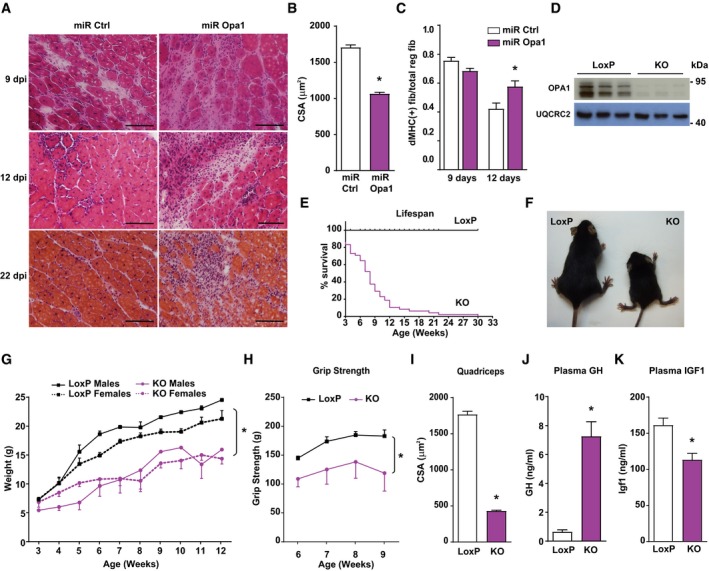-
A
Transversal sections of gastrocnemius muscles of 3‐month‐old mice injected with CTX as an injury‐induced model and, 2 days later, with adenoviruses encoding for non‐targeting miRNA (miR Ctrl) or miRNA targeting Opa1 (miR Opa1). Samples were taken on various days after the injury (dpi, n = 5). Scale bars, 100 μm.
-
B
Mean cross‐sectional area (CSA) of 150 myofibers per gastrocnemius muscle at dpi 12.
-
C
Quantification of positive MHC myofibers vs. total regenerating myofibers of gastrocnemius muscle treated with miR Ctrl or miR Opa1 adenoviruses at dpi 9 and 12 (n = 5).
-
D
Opa1 protein levels in tissue homogenates of control (loxP) and skeletal muscle‐specific KO mice (KO). The skeletal muscle used was gastrocnemius muscle (n = 6).
-
E
Survival curves for loxP and Opa1 KO mice (n = 25).
-
F
Picture of loxP and KO mice at 9 weeks of age.
-
G
Body weight of loxP and KO male and female mice (n = 25).
-
H
Grip strength in loxP and KO mice. loxP (n = 7) and KO (n = 4).
-
I
Mean cross‐sectional area (CSA) of 150 myofibers in quadriceps muscle.
-
J–K
Plasma concentration of growth hormone (GH) (J) and Igf1 (K) of loxP (n = 8) and KO mice (n = 10).
Data information: Data represent mean ± SEM. *
P < 0.001 vs. control loxP mice (with the exception of panel B in which
P < 0.01). Data were analyzed using Student's
t‐test (B, C, I, J, and K) or analysis of variance test (G and H).

